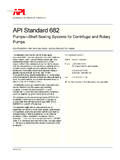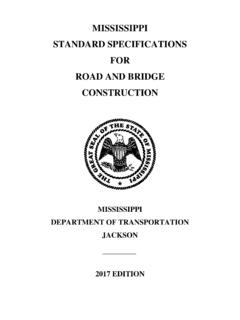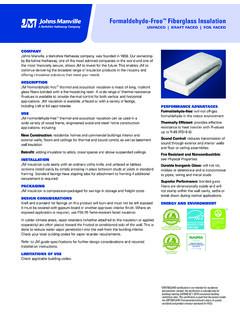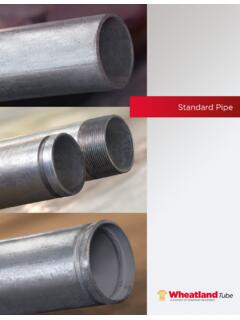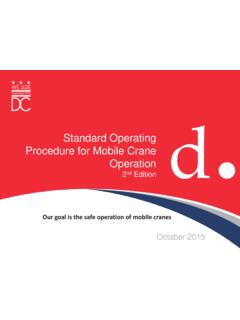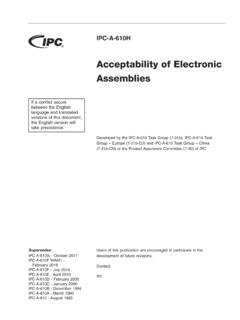Transcription of Acceptability of Electronic Assemblies
1 IPC-A-610 DAcceptability of ElectronicAssemblies2nd Proposed Standard for BallotASSOCIATION CONNECTINGELECTRONICS INDUSTRIES 3000 Lakeside Drive, Suite 309S, Bannockburn, IL 60015-1219 Tel. Fax 2004A standard developed by IPCS upersedes A-610 CJanuary 2000 The Principles ofStandardizationIn May 1995 the IPC s Technical Activities Executive Committee adopted Principles ofStandardization as a guiding principle of IPC s standardization Should: Show relationship to Design for Manufacturability(DFM) and Design for the Environment (DFE) Minimize time to market Contain simple (simplified) language Just include spec information Focus on end product performance Include a feedback system on use andproblems for future improvementStandards Should Not.
2 Inhibit innovation Increase time-to-market Keep people out Increase cycle time Tell you how to make something Contain anything that cannotbe defended with dataNoticeIPC standards and Publications are designed to serve the public interest through eliminating mis-understandings between manufacturers and purchasers, facilitating interchangeability and improve-ment of products, and assisting the purchaser in selecting and obtaining with minimum delay theproper product for his particular need. Existence of such standards and Publications shall not inany respect preclude any member or nonmember of IPC from manufacturing or selling productsnot conforming to such standards and Publication, nor shall the existence of such standards andPublications preclude their voluntary use by those other than IPC members, whether the standardis to be used either domestically or standards and Publications are adopted by IPC without regard to whether their adop-tion may involve patents on articles, materials, or processes.
3 By such action, IPC does not assumeany liability to any patent owner, nor do they assume any obligation whatever to parties adoptingthe Recommended Standard or Publication. Users are also wholly responsible for protecting them-selves against all claims of liabilities for patent PositionStatement onSpecificationRevision ChangeIt is the position of IPC s Technical Activities Executive Committee (TAEC) that the use andimplementation of IPC publications is voluntary and is part of a relationship entered into bycustomer and supplier. When an IPC publication is updated and a new revision is published, itis the opinion of the TAEC that the use of the new revision as part of an existing relationshipis not automatic unless required by the contract.
4 The TAEC recommends the use of the October 6. 1998 Why is therea charge forthis document?Your purchase of this document contributes to the ongoing development of new and updated industrystandards and publications. standards allow manufacturers, customers, and suppliers to understandone another better. standards allow manufacturers greater efficiencies when they can set up theirprocesses to meet industry standards , allowing them to offer their customers lower spends hundreds of thousands of dollars annually to support IPC s volunteers in the standardsand publications development process. There are many rounds of drafts sent out for review andthe committees spend hundreds of hours in review and development.
5 IPC s staff attends and par-ticipates in committee activities, typesets and circulates document drafts, and follows all necessaryprocedures to qualify for ANSI s membership dues have been kept low to allow as many companies as possible to , the standards and publications revenue is necessary to complement dues revenue. Theprice schedule offers a 50% discount to IPC members. If your company buys IPC standards andpublications, why not take advantage of this and the many other benefits of IPC membership aswell? For more information on membership in IPC, please visit or call 847 you for your continued support. Copyright 2004. IPC, Bannockburn, Illinois.
6 All rights reserved under both international and Pan-American copyright copying,scanning or other reproduction of these materials without the prior written consent of the copyright holder is strictly prohibited and constitutesinfringement under the Copyright Law of the United forElectronic AssembliesDeveloped by the IPC Task Group (7-31b) of the Product AssuranceSubcommittee (7-30) of IPCU sers of this publication are encouraged to participate in thedevelopment of future :IPC3000 Lakeside Drive, Suite 309 SBannockburn, Illinois60015-1219 Tel 847 847 :IPC-A-610C - January 2000 IPC-A-610B - December 1994 IPC-A-610A - March 1990 IPC-A-610 - August 1983 ASSOCIATION CONNECTINGELECTRONICS INDUSTRIES This Page Intentionally Left BlankTable of Contents 1 Forward 1-1 Scope 1-2 Purpose 1-3 Specialized Designs 1-3 Terms & Definitions 1-3 Classification 1-3 Acceptance Criteria 1-3 Target Condition 1-4 Acceptable Condition 1-4 Defect Condition 1-4
7 Process Indicator Condition 1-4 Combined Conditions 1-4 Conditions Not Specified 1-4 Board Orientation 1-4 *Primary Side 1-4 *Secondary Side 1-5 Solder Source Side 1-5 Solder Destination Side 1-5 Cold Solder Connection 1-5 Electrical Clearance 1-5 High Voltage 1-5 Intrusive Solder 1-5 Leaching 1-5 Meniscus (Component) 1-5 Pin-in-Paste 1-5 Wire Diameter 1-5 Examples and Illustrations 1-5 Inspection Methodology 1-5 Verification of Dimensions 1-6 Magnification Aids and Lighting 1-6 2 Applicable Documents 2-1 IPC Documents 2-1 Joint Industry Documents 2-1 EOS/ESD Association Documents 2-2 Electronics Industries Alliance Documents 2-2 International Electrotechnical Commission Documents 2-2 3 Handling Electronic
8 Assemblies 3-1 EOS/ESD Prevention 3-2 Electrical Overstress (EOS) 3-3 Electrostatic Discharge (ESD) 3-4 Warning Labels 3-5 Protective Materials 3-6 EOS/ESD Safe Workstation/EPA 3-7 Handling Considerations 3-9 Guidelines 3-9 Physical Damage 3-10 Contamination 3-10 Electronic Assemblies 3-10 After Soldering 3-11 Gloves and Finger Cots 3-12 4 Hardware 4-1 Hardware Installation 4-2 Electrical Clearance
9 4-2 Interference 4-3 Threaded Fasteners 4-3 Torque 4-6 Wires 4-7 Connectors, Handles, Extractors, Latches 4-9 Connector Pins 4-10 Edge Connector Pins 4-10 Press Fit Pins 4-12 Soldering 4-16 Backplanes 4-18 Wire Bundle Securing 4-19 General 4-19 Lacing 4-22 Damage 4-23 Routing 4-24 Wire Crossover 4-24 Bend Radius 4-25 Coaxial Cable 4-26 Unused Wire Termination 4-27 Ties over Splices and Ferrules 4-28 Table of Contents 5 Soldering 5-1 Soldering Acceptability
10 Requirements 5-2 +Soldering Anomalies 5-7 Exposed Basis Metal 5-7 Pin Holes/Blow Holes 5-9 Reflow of Solder Paste 5-10 Nonwetting 5-11 Dewetting 5-12 Excess Solder 5-13 Solder Balls/Solder Fines 5-13 Bridging 5-15 Solder Webbing 5-16 Disturbed Solder 5-17 Fractured Solder 5-18 Solder Projections 5-19 Lead Free Fillet Lift 5-20 Hot Tear/Shrink Hole 5-21 6 Terminal Connections 6-1 Edge Clip 6-1 Swaged Hardware 6-3 Rolled Flange 6-4 Flared Flange 6-5 Flared Flange - Controlled Split 6-6 Terminals 6-7 Turret 6-7 Bifurcated 6-8 Flared Flange Hardware Fused in Place 6-9 Wire/Lead Preparation.
